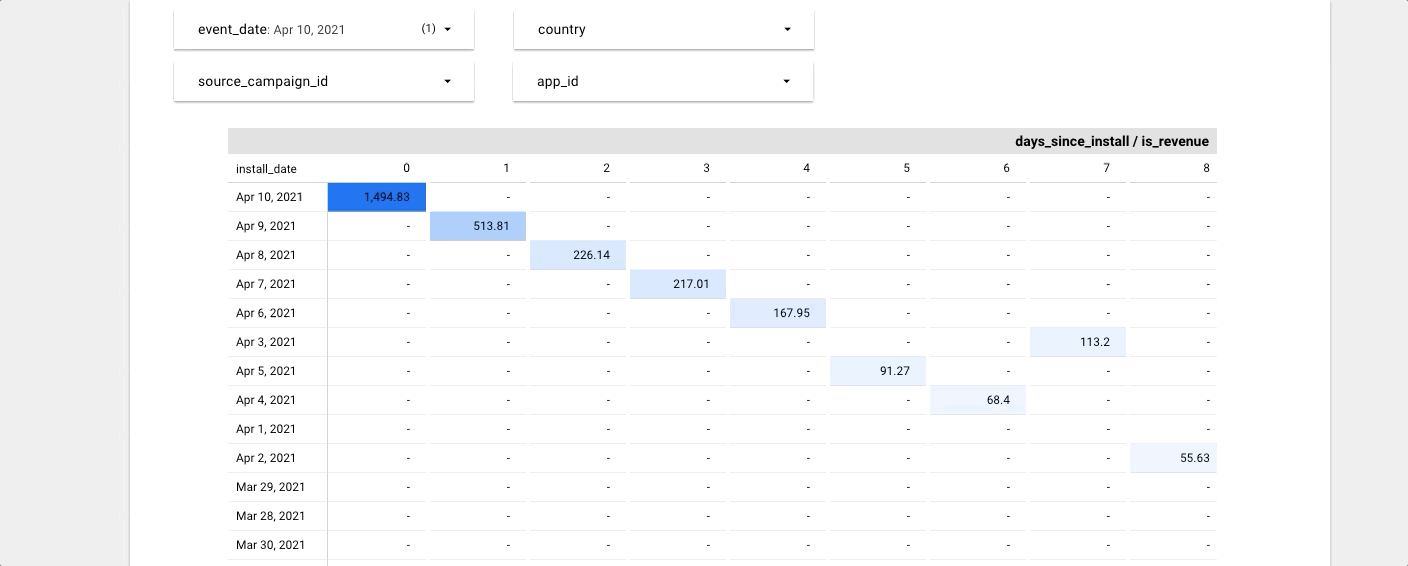Merge ironSource ULRD & Tenjin Cohort Data
Overview
Learn how to merge data from the ironSource Monetization Reporting API for user-level revenue data (ULRD) with Tenjin’s DataVault.
Upon completion of this training, you will have a comprehensive overview of the following:
- What a dashboard with combined data and metrics looks like
- How you can create cohort views
- What you can do with the combined data and what the use cases are
Here’s a glimpse of what the dashboard view with these combined data and metrics looks like:

What can these reports be used for?
The revenue data from the ironSource ULRD is merged with Tenjin’s DataVault to show you user-level data sorted by install date and campaign_id. These reports can be used to analyze how much revenue your apps are generating after an install.
Important Note: All our Paid trainings include SQL/dashboard/script for which access is only provided to customers who have a paid subscription to the service. You can get in touch with us if you would like to subscribe.
Summary
What you will learn
This Google Data Studio dashboard displays two views that are built on top of the ironSource Monetization Reporting API for ULRD & Tenjin’s DataVault. The views help you understand how much revenue is generated by your apps after an install, grouped by install data or campaign ID, and how much progress the apps have made over time.
How it works
The data is pulled from the ironSource API and Tenjin’s attribution. You could either use this dashboard to build your own ETL view of the cohort data, or use Growth FullStack’s managed ETL services to analyze the data.
Setup
Merge your ironSource User-Level Revenue Data (ULRD) with Tenjin’s attribution
The Google Data Studio dashboard has two views:
- Revenue from ironSource ULRD/cohorted by days since install, sorted by install date
- Revenue from ironSource ULRD/cohorted by days since install, sorted by campaign ID
Customize your dashboard to meet your needs
This dashboard is built on top of anonymized data from the ironSource Reporting API and Tenjin’s DataVault, and can be easily customized for your apps. Customers who want to run their own ETL can use this dashboard to understand the use cases of both datasets and spec out the view your data analysts should build.
Step-by-step guide on how you can set up your dashboard
Growth FullStack customers who want to use our managed ETL pipeline services can use this dashboard as a template. Follow the steps below to get started:
Step 1: Connect to your Google Data Studio account. If you don’t already have an account, you can create one here for free.
Step 2: View our anonymized template.
Step 3: Click on the icon that allows you to make a copy of the report inside the template. This will show you a pop-up.
Step 4: Select a data source. You will then be able to see ‘view_ironsource_revenue’ as a new data source. You need to be logged in with the Google account that has access to the dataset where the data was loaded. You can check if you have access by clicking here. This will allow you to see the template with your own metrics.
What you need
You need to have data from Tenjin’s DataVault and ironSource ULRD in your data warehouse environment (Redshift and Bigquery are supported). If you are using BigQuery, you can use Growth FullStack’s managed ETL to push the Tenjin DataVault data and ironSource ULRD data into BigQuery.
How To
Get access to the anonymized template below:
Note: This template is available for a wide range of BI tools such as Looker, Metabase or Tableau. Feel free to get in touch with your Growth FullStack Account Manager for any additional details on the matter.
Google Data Studio Dashboard views
The following Google Data Studio dashboard views allow you to see your ironSource ULRD data joined on user level with Tenjin’s DataVault data. Both views allow you to analyze how much revenue your apps are generating after an install.
-
View 1: Revenue from ironSource/cohort by days since install, and sorted by install date

-
View 2: Revenue from ironSource ULRD/cohort by days since install, sorted by campaign ID

Note: Both of these views can be split into further dimensions—such as site ID.
FAQ
Do you support a template based on ironSource Ad Revenue Measurement API for impression-level revenue data (ILRD)?
This training has not (yet) been requested by our clients. Please contact your Growth FullStack Account Manager if you’re interested in this content.
Can this dashboard be personalized as per my requirements?
Yes. In the Calculated Fields section of Data Studio, you will be able to see the fields and dimensions that are available from the ironSource Metrics API and Tenjin’s DataVault.
Contact your Growth FullStack Account Manager for more details on how to personalize the dashboard.
Currently, the following dimensions are available:

Feedback
Do you have any feedback for us?
We at Growth FullStack are always happy to receive your valuable feedback. Whether it’s about requesting additional support on optimizing your workflows, building a customized dashboard, or anything else, feel free to reach out to us and let us know how we can support you further.
Iterate and Maintain
Iterate
This dashboard can be edited. Please read this background on Controls in Google Data Studio before proceeding with this template. Setting up controls to create drop-down lists will allow you to filter the data you require.
Maintain
Please be aware that ironSource frequently updates its API and this may break the template.
